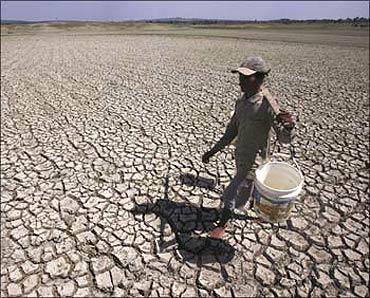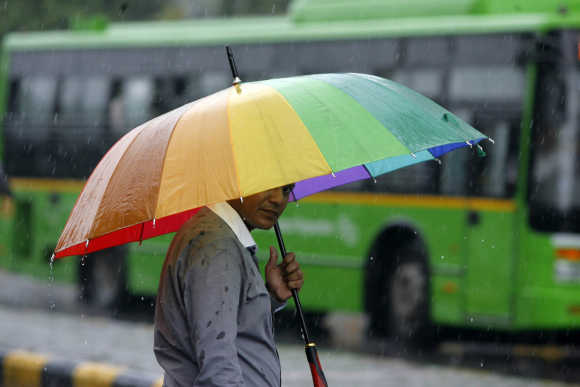BS Reporter in New Delhi
As the southwest monsoon enters a lean patch after moving vigorously over much of India in the last fortnight, water levels in major reservoirs have started dwindling.
Though most experts believe it is not unusual for water levels to fall during this time of the year, what is striking is the fact that the water levels now almost match their 10-year average.
Data from the Central Water Commission shows that at present water levels in 81 major reservoirs across the country are at 16 per cent of the live capacity at Full Reservoir Level.
. . .
Rainfall 23% below normal, reservoirs run dry
Image: A child at a water pump in Bihar.Photographs: Reuters
The 10-year average water level during the same period is also estimated to be around 16 per cent of FRL.
Live capacity at FRL, which is total water stored in the reservoirs when they are full to the brim is estimated to be 154.42 billion cubic metres.
Water in major reservoirs across the country has dipped because the southwest monsoon this year has had an uneven rainfall across the country so far.
The monsoon, which reached the country after a delay of almost 4 days, has covered only half of India so far.
In normal conditions, monsoon should have progressed far beyond north India by end June.
. . .
Rainfall 23% below normal, reservoirs run dry
Image: People stand on a seaside promenade against the background of pre-monsoon clouds gathered over the Arabian Sea at Kochi in Kerala. A file photo.Photographs: Sivaram V/Reuters
Much of north, central and some parts of western India are yet to get the first monsoon showers.
The India Meteorological Department on Thursday said that in the fourth week of June, rainfall was 18 per cent below average.
Rainfall so far since June 1 have been 23 per cent below average, compared to a 10.7 per cent surplus during the period from June 1 to June 29 last year.
Rains picked up in the week to June 20 to just 5 per cent below average, helping sowing in some areas.
The southwest monsoon is crucial to Indian agriculture as almost 55 per cent of the total arable land does not have irrigation facilities.
. . .
Rainfall 23% below normal, reservoirs run dry
Image: A man holds his umbrella as he crosses a road during rains in New Delhi. A file photo.Photographs: Mukesh Gupta/Reuters
The farm sector accounts for about 15 per cent of the nearly $2 trillion Indian economy.
Officials in the Union agriculture ministry said the next two weeks would be crucial, as late sowing can hit crop yields.
The ministry is keeping a cut-off date for the first week of July, after which it will start putting in place contingency measures.
"We will monitor the situation till the first week of July and if rainfall does not improve, then contingency steps need to be taken," a senior official at the department of agriculture said.
The weather office has forecast average rainfall in the vital sowing month of July, when monsoon normally covers the entire country.
The monsoon is key to the growth of summer crops such as rice, corn, cane, oilseeds and cotton.






article